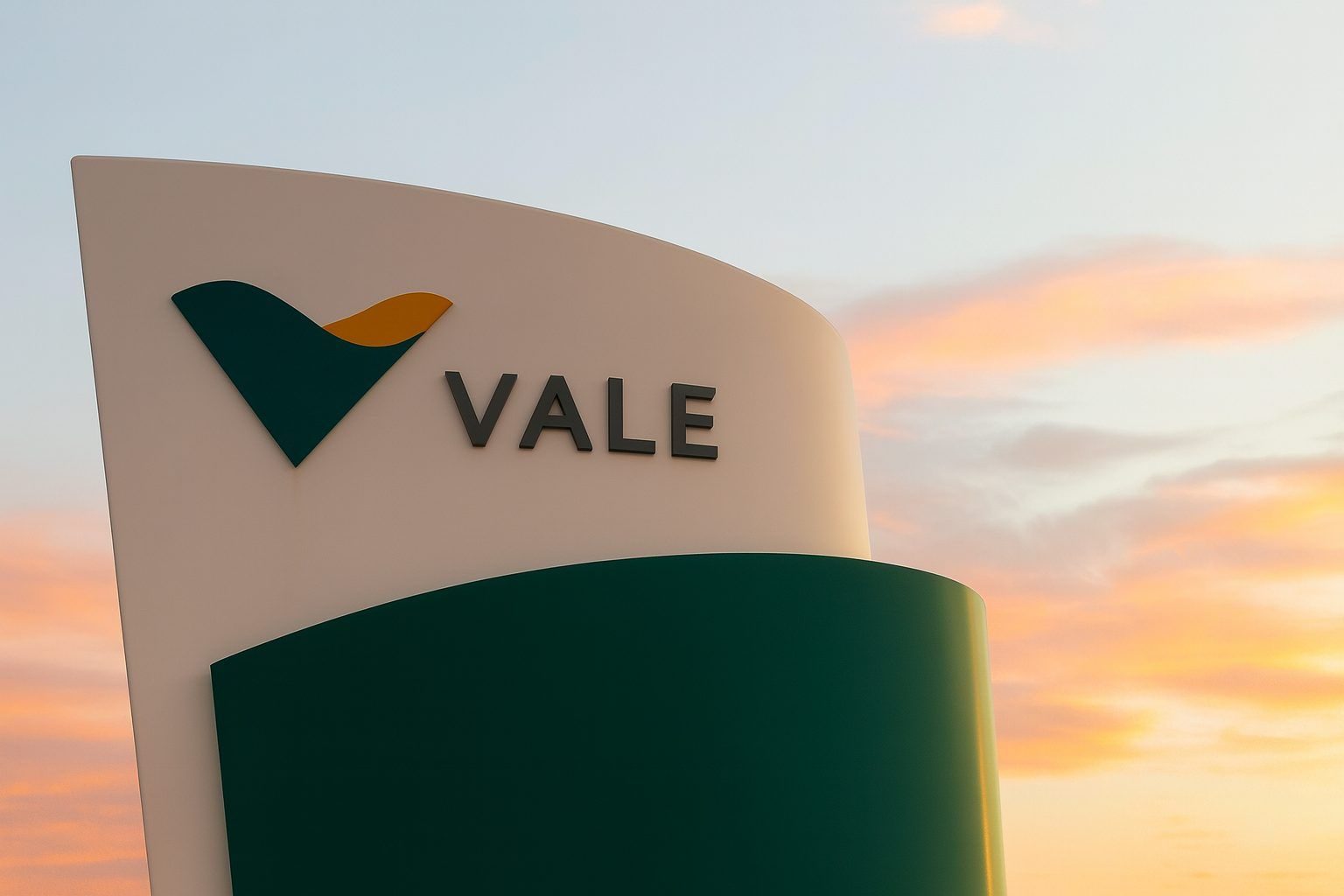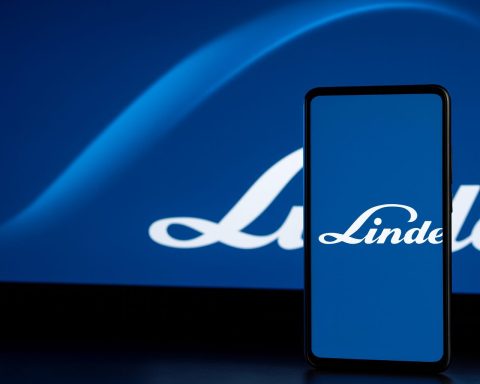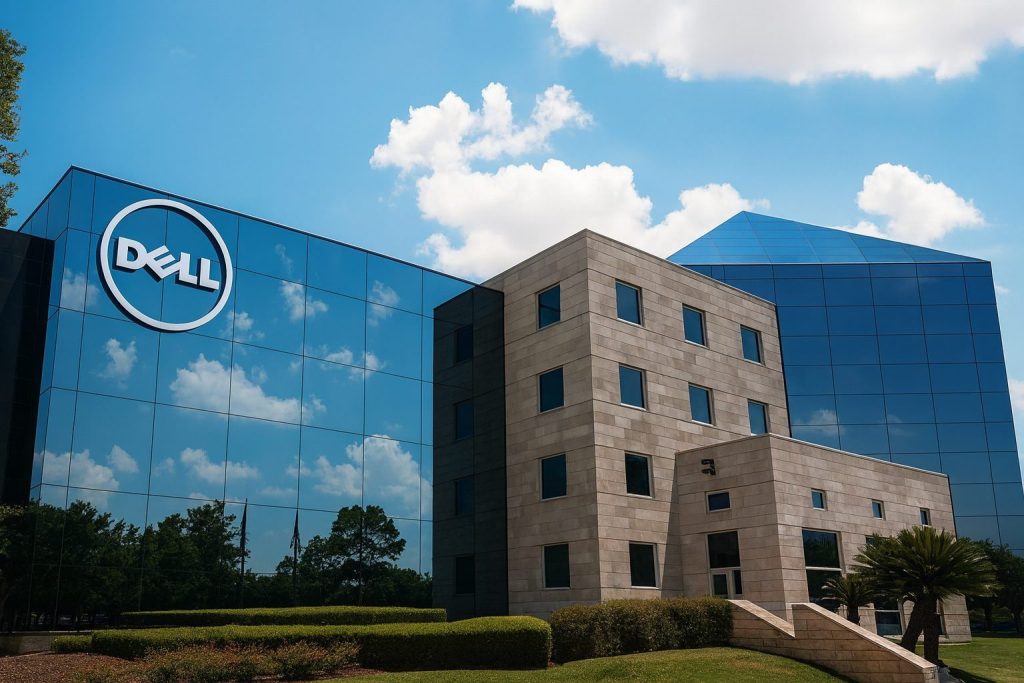Vale S.A. (NYSE: VALE), the Brazilian iron ore and base‑metals giant, is trading higher today as investors digest record third‑quarter results, a fresh ownership breakdown, and new headlines about U.S. political trading and the upcoming “Vale Day 2025” investor event.
Vale stock price today (VALE, VALE3) – November 26, 2025
As of early afternoon on Wednesday, November 26, 2025, Vale’s U.S.‑listed ADRs are trading around $12.52–$12.53, up roughly 2.7–2.8% from Tuesday’s close of $12.19. [1]
Key intraday stats for the NYSE‑listed VALE:
- Last price: ~$12.53
- Day change: about +$0.33 (≈ +2.7–2.8%) vs. prior close [2]
- Intraday range: roughly $12.25 – $12.53
- Latest volume: ~16.6 million shares, indicating healthy liquidity mid‑session [3]
- 52‑week range:$8.06 – $12.60, putting today’s price just below the top of its one‑year band [4]
On fundamentals, MarketBeat data show Vale with:
- Market cap: ~$55 billion
- Trailing P/E: ~9.8x
- Debt‑to‑equity ratio: about 0.48
- Current ratio:1.22, quick ratio0.85 [5]
In Brazil, Vale’s primary listing VALE3 on B3 is trading around BRL 66.75 today, implying a strong year‑to‑date gain; Yahoo Finance data put VALE3’s YTD return near 29% as of November 25, 2025. [6]
The latest Vale stock news on November 26, 2025
1. U.S. congresswoman trims a small Vale position
One of today’s most specific headlines for Vale investors comes from MarketBeat: Rep. Lisa C. McClain (R‑Michigan) disclosed a modest sale of Vale shares. [7]
According to the filing:
- On October 31, 2025, McClain sold between $1,001 and $15,000 of VALE shares from a Charles Schwab 401(k) account.
- The sale was part of a broader batch of similar‑sized trades in multiple stocks (from tech to consumer names) executed the same day. [8]
Why it matters:
- In absolute terms, this is tiny compared with Vale’s roughly $55 billion market cap and has no direct fundamental impact. [9]
- However, congressional trading is closely watched by some retail investors, and the article uses the disclosure as a springboard to recap Vale’s fundamentals, including:
- Q3 EPS of $0.63 vs. $0.49 expected
- Revenue of $10.42 billion, slightly ahead of consensus
- An analyst‑tracked 12‑month trading range of $8.06–$12.60 and a consensus “Moderate Buy” rating with an average target near $12.61 [10]
Overall, this is a sentiment headline rather than a thesis‑changing development.
2. New ownership snapshot: institutions hold 50% of Vale
Also today, Simply Wall St published a fresh look at Vale’s shareholder base for the São Paulo–listed VALE3 shares. [11]
Key takeaways:
- Institutional investors hold about 50% of Vale’s share capital.
- The top 25 shareholders together control roughly 45% of the company.
- The largest single shareholder is Caixa de Previdência dos Funcionários do Banco do Brasil (the pension fund for Banco do Brasil employees), with about 9.3% ownership.
- The general public (retail and small investors) holds an estimated 43%, while other public companies own around 6.7%. [12]
What this means for the stock:
- High institutional ownership generally signals strong interest from large, professional investors, which can support liquidity and coverage.
- At the same time, the article notes that heavy institutional concentration can make the share price more sensitive to big allocation shifts or redemptions in those funds. [13]
For VALE ADR holders, this ownership breakdown on VALE3 is still relevant, since the ADRs represent the same underlying equity.
3. Macro backdrop: global poll flags Brazil political risk
A Reuters‑linked market commentary out today on global stocks in 2026 highlights that, while strategists expect moderate gains next year, political risk is a watch‑point in Brazil ahead of the 2026 presidential election. [14]
The piece notes that large Brazilian corporates such as Petrobras and Vale could see higher risk premiums and volatility if political uncertainty rises or policy becomes less market‑friendly. [15]
This isn’t Vale‑specific news, but it’s important context: foreign investors in VALE are always exposed to Brazilian macro and political risk on top of commodity cycles.
Fundamentals in focus: record Q3 production and improving cash flows
Even though today’s headlines are lighter on new fundamentals, the current trading in VALE is still anchored in recent Q3 numbers, which were among the strongest in years.
Record iron ore output and stronger earnings
According to Vale’s Q3 2025 results and subsequent analyses: [16]
- Iron ore production reached about 94 million tonnes, up ~4% year‑on‑year and the highest quarterly output since 2018. [17]
- Iron ore sales were roughly 86 million tonnes, up about 5% YoY. [18]
- Copper production increased ~6% YoY, continuing a gradual recovery in the base‑metals business. [19]
- The second furnace at Onça Puma added ~15,000 tonnes per year of nickel capacity and is expected to reduce nickel unit costs by ~10%. [20]
Financially:
- Adjusted EBITDA came in around $4.4 billion, up 17% year‑on‑year and about 28% higher than Q2, driven by volumes, better realized iron ore prices and cost discipline. [21]
- Recurring free cash flow reached roughly $1.6 billion, up about $1 billion YoY, while total free cash flow was about $2.6 billion including proceeds from an energy asset transaction. [22]
- Net debt decreased by roughly $800 million in the quarter, landing near $16.6 billion. [23]
From the MarketBeat earnings summary:
- Q3 EPS was $0.63, beating the consensus estimate of $0.49.
- Revenue was $10.42 billion, slightly ahead of expectations around $10.39 billion.
- Vale generated a return on equity of ~18% and posted a net margin of about 14% for the quarter. [24]
Management and third‑party commentary suggest Q3 positions Vale to hit the upper end of its 2025 production guidance, especially in iron ore. [25]
Strategic moves and upcoming catalysts
1. Vale Day 2025 in London – December 2
The next major near‑term catalyst is Vale Day 2025, the company’s annual capital‑markets event, which will be held in London on December 2, 2025 and webcast live in English and Portuguese. [26]
The company has signaled it will use the event to:
- Update investors on its long‑term strategy and capital allocation;
- Provide more detail on major projects in its Northern System and “Novo Carajás” program;
- Discuss progress in base metals and energy‑transition materials. [27]
TipRanks highlights that the latest analyst rating in its system is a “Hold” with a $12.90 price target, while its AI “Spark” model rates VALE as “Outperform”, citing strong technical indicators, solid earnings and an attractive dividend profile. [28]
Investors will be watching Vale Day closely for 2026–2028 production targets, dividend policy hints, and any new color on asset sales (especially in base metals) or further debt reduction.
2. Pivoting toward India and diversifying away from China
In a mid‑November interview with Reuters, CEO Gustavo Pimenta said Vale is “gearing up” to meet surging iron ore demand from India as the country’s steel capacity is expected to roughly double to ~300 million tonnes in the next 5–7 years. [29]
Highlights from that interview:
- India is expected to import around 10 million tonnes of Vale ore this year, up from almost nothing a few years ago — still small versus China, but growing fast. [30]
- China currently accounts for roughly 60% of Vale’s sales, but steel output there is flat at around 1 billion tonnes and could edge lower over time. [31]
- Vale plans to invest 70 billion reais (≈ $13 billion) by 2030 in its “Novo Carajás” program in northern Brazil, including a project to boost annual iron ore capacity by ~20 million tonnes by 2026. [32]
- The company also aims to double copper output by 2035, reflecting its ambition to be a key energy‑transition materials supplier. [33]
Pimenta has also said Vale expects to reclaim the title of the world’s largest iron ore producer this year, after losing it to Rio Tinto in the aftermath of the 2019 Brumadinho disaster. [34]
3. Cleaning up the capital structure: buybacks and perpetual notes
Vale has been actively reshaping its balance sheet in 2025:
- In February 2025, the company reported a $694 million Q4 loss due largely to $1.94 billion in impairments on nickel assets in Canada (Thompson and Voisey’s Bay expansions). At the same time, it:
- Announced a dividend of ~2.14 Brazilian reals per share;
- Launched a share buyback program of up to 120 million shares, about 3% of its share base;
- Cut its 2025 capital‑expenditure guidance by ~9% to $5.9 billion. [35]
- In October 2025, Vale moved to buy back up to about $3.1 billion worth of “participating debentures” — perpetual notes tied to a slice of revenue from certain iron ore, copper and gold operations.
- The company offered 42 reals per note, above their prior trading price around 36 reals.
- These instruments have effectively been costing Vale around 13% in dollar terms, versus about 6.1% for its long‑dated U.S. dollar bonds, making them a priority target for retirement. [36]
Taken together, these actions point to a strategy of simplifying the capital structure, focusing spending on higher‑return projects, and returning more cash to shareholders when conditions allow.
How analysts and models see Vale stock right now
Street research
MarketBeat’s roundup of analyst opinions shows: [37]
- Consensus rating:“Moderate Buy.”
- Rating mix: 2 “Strong Buy”, 8 “Buy”, 5 “Hold”, 1 “Sell.”
- Average price target: about $12.61, only slightly above today’s ~$12.5 spot price.
- Recent moves include:
- Barclays lifting its target from $13.80 to $14.50 with an “Overweight” rating.
- Scotiabank upgrading Vale from “sector perform” to “sector outperform” with a $14.00 target.
- Wells Fargo nudging its target from $11.00 to $12.00, but keeping a more cautious stance.
In other words, the sell‑side view is constructive but not euphoric: many analysts see Vale as attractively valued versus earnings and cash flow, but still tied to volatile iron ore prices, base‑metals cycles and Brazilian risk.
Quant and technical views
- TipRanks’ AI “Spark” model rates VALE as “Outperform”, citing strong technical momentum, robust earnings trends and an appealing dividend yield; its most recent human analyst rating in that system is “Hold” with a $12.90 target. [38]
- Technical‑analysis platform StockInvest.us currently classifies VALE as a “Buy or Hold candidate”, noting:
- Short‑ and long‑term moving averages both pointing up;
- A strong rising short‑term trend since late August;
- A model‑based forecast that VALE could trade in the $14.40–$15.52 range over the next three months with a 90% probability band, if the current trend persists. [39]
Those model‑driven forecasts can be useful sentiment indicators, but they rely heavily on past price patterns and can change quickly as markets move.
Key risks and what investors should watch next
Even with today’s positive price action, several risk factors remain front of mind:
- Commodity price exposure: Vale’s earnings are highly sensitive to iron ore, copper and nickel prices. A sustained downturn in steel demand or oversupply in iron ore could pressure margins. (This is an inherent sector risk rather than new news.)
- China vs. India demand shift: China still buys around 60% of Vale’s ore, and while demand there is flat or gently declining, pricing power is also contested as China tries to exert more influence on benchmark pricing. The pivot to India and Southeast Asia is promising but will take time to fully offset any long‑term Chinese slowdown. [40]
- Legal and ESG overhangs:
- Vale continues to deal with legacy litigation related to the Samarco/Brumadinho dam disasters, including cases in the U.K. involving BHP that keep tailings issues in the spotlight. [41]
- On the positive side, Vale reports that it has implemented global tailings management standards and removed its last dam from the highest emergency level, but regulators and investors remain vigilant. [42]
- Brazil political and regulatory risk: As noted in the latest global equity poll, investors may demand a higher risk premium on Brazilian assets such as Vale ahead of the 2026 election, especially if fiscal or regulatory uncertainty rises. [43]
- Currency and interest‑rate risk: Vale earns revenue predominantly in U.S. dollars but reports in both USD and BRL, and it carries a mix of real‑ and dollar‑denominated debt. FX swings and global rate moves can influence both earnings translation and funding costs.
What to watch next:
- Vale Day 2025 (Dec 2): Guidance for 2026–2028 iron ore and copper volumes, updates on the Novo Carajás project, and any news on asset sales or special dividends. [44]
- Iron ore price trend into 2026: Whether Chinese demand stabilizes and how quickly Indian imports ramp. [45]
- Progress on the participating debenture buyback and share repurchases: This will shape Vale’s future cash cost of capital and per‑share metrics. [46]
- Any regulatory or legal developments around tailings, Samarco‑related claims, or Brazilian tax changes on dividends. [47]
Bottom line
On November 26, 2025, Vale’s stock is trading near its 12‑month highs, supported by record Q3 iron ore production, improved cash generation, active balance‑sheet clean‑up and broadly positive (if measured) analyst sentiment. Today’s incremental headlines — a small congressional sale and a fresh institutional‑ownership breakdown — are more about color and context than fundamentals, but they reinforce the picture of Vale as a heavily institutionally owned, globally watched commodity heavyweight.
That said, Vale remains tightly linked to commodity prices, Chinese and Indian steel cycles, Brazilian politics and ongoing ESG scrutiny — all of which can drive volatility in both directions.
Important: This article is for informational and editorial purposes only and does not constitute investment advice or a recommendation to buy or sell any security. Always do your own research and consider speaking with a qualified financial advisor before making investment decisions. Past performance is not a guarantee of future results.
References
1. markets.businessinsider.com, 2. markets.businessinsider.com, 3. stockanalysis.com, 4. www.marketbeat.com, 5. www.marketbeat.com, 6. www.investing.com, 7. www.marketbeat.com, 8. www.marketbeat.com, 9. www.marketbeat.com, 10. www.marketbeat.com, 11. simplywall.st, 12. simplywall.st, 13. simplywall.st, 14. markets.financialcontent.com, 15. markets.chroniclejournal.com, 16. vale.com, 17. www.gurufocus.com, 18. www.gurufocus.com, 19. www.gurufocus.com, 20. www.gurufocus.com, 21. www.gurufocus.com, 22. www.gurufocus.com, 23. www.gurufocus.com, 24. www.marketbeat.com, 25. www.investing.com, 26. www.tipranks.com, 27. www.reuters.com, 28. www.tipranks.com, 29. www.reuters.com, 30. www.reuters.com, 31. www.reuters.com, 32. www.reuters.com, 33. www.reuters.com, 34. www.reuters.com, 35. www.reuters.com, 36. www.mining.com, 37. www.marketbeat.com, 38. www.tipranks.com, 39. stockinvest.us, 40. www.reuters.com, 41. www.reuters.com, 42. www.gurufocus.com, 43. markets.chroniclejournal.com, 44. www.tipranks.com, 45. www.reuters.com, 46. www.mining.com, 47. www.gurufocus.com







